Fruit trees and vines can provide an enormous amount of food compared to the effort invested. Many fruit and nut trees produce, literally, bushels of fruits or nuts, and some blackberry variants produce gallons of berries per vine. Unfortunately, even though berries may even produce in their first or second season, full-sized fruit and nut trees take several years to come into production and may produce nothing at all for the first few years. Dwarf trees will normally produce fruit within three years, but the volume of fruit they produce is lower.
To offset this problem, diversify! If possible, in the year preceding the start of your mini-farm, plant a small section with berry and perhaps some grape vines for the next year's harvest. Along with these, plant dwarf fruit trees and some full-sized nut trees. In this way, the harvest starts modestly with berries the first year and expands to include dwarf cherries the next year , dwarf apples the year after that, and so on. Within seven years, the farmer is producing enough fruit and nuts for the family plus some surplus.
Fruits are full of idiosyncrasies in terms of disease and pest problems, pruning requirements, suitable climate, and so on. This is particularly true of vinifera grapes, apples, peaches, and other popular fruits. I recommend reading as widely as possible about the fruits you plan to grow and selecting hardy varieties specific to your area, using a reputable nursery, and trying to purchase varieties that are resistant to expected diseases.
I recommend St. Lawrence Nurseries in Potsdam, New York, but there are other reputable nurseries as well. An invaluable Internet resource at the time of this writing is Garden Watchdog, at www.davesgarden.com. Garden Watchdog has a listing for almost every company in the gardening business and a list of feedback from customers along with ratings. Check out any mail-order nurseries with Garden Watchdog before ordering.
In addition to ordering high-quality trees that are likely to be less susceptible to problems, you should work proactively to keep pest problems minimal by making sure plants that attract beneficial insects are already established where the trees will be planted. Most notably, this means clover. Clover attracts insects that feast on the most tenacious pests of apple-family trees and fruits such as codling moths, apple maggots, and plum curculios. The exact type of clover to be planted will vary with the condition of the soil, expected temperatures, and expected precipitation. A good resource for selecting the right variety of clover is a comprehensive organic gardening catalog like that from Farm Supply.
Plant trees in the spring, and spray them for the first time in the fall with dormant oil that smothers and controls overwintering insects. The following spring spray the trees with a lighter horticultural oil in spring when the buds have swelled but not yet blossomed. Also spray them with either a lime sulfur or organic copper-based fungicide according to label directions every spring after their first year . Traps for common problem insects such as codling moths or apple maggots should be set out and maintained at a high enough density to trap out all of the males of the species.
Fruits and nuts often have specific pollination requirements that make it necessary to plant more than one tree. Sometimes the trees have to be of slightly different variants because trees of the same variety were propagated by grafting and are therefore genetically identical and self-sterile. A few nurseries sell trees propagated from seed rather than grafting, and these trees will pollinate each other without issue even if the same variety. Be sure to pay attention to catalog information and ask questions of the nursery staff to avoid later disappointment! Pruning will be necessary to maximize the productive potential of the trees. There are many schools of thought on the subject of pruning, and numerous weighty tomes have been written, but the basics are easily described.
Blackberries and Raspberries
Cane fruits, like raspberries and blackberries, grow long and heavy enough that the tips of the canes touch the ground-where they then set a new root and grow more new canes. This isn't necessarily desirable, as it leads to an ever-expanding impenetrable thorny mess, so it is best to trellis the canes to prevent this. The easiest trellising for cane fruits is a four-foot-tall "T" at each end of the row of canes with galvanized wire run from each end of the T along the length of the row. The wire holds up the canes so they don't touch the ground, and new canes are trained to stay behind the wire. This makes the berries easy to pick as well.
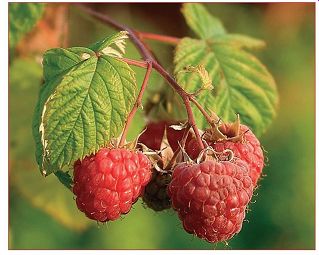
---------------- Raspberries are nutritious and easy to grow.
Blackberries are pruned by distinguishing between primocanes and floricanes. Primocanes are canes in their first year that bear leaves but no flowers or fruit. Floricanes are those same canes in their second year, when they bear flowers and fruit. After a cane has fruited, it slowly dies, so fruiting canes should be cut out and removed once their fruiting season has passed. Primocanes should b e topped during their first year of growth, meaning they should have their tops cut off just about 4 inches above the trellis. This will cause them to send out lateral shoots so that when they bear fruit the next year , they will bear more abundantly.
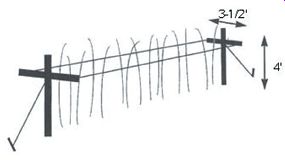
The lateral shoots should be trimmed to 12 inches to 18 inches.
----------------- This sort of T-trellis is easily made and works well The same general technique applies to raspberries, with some minor changes. Yellow and red raspberries shouldn't be topped, and the laterals that form on purple and black raspberries should be trimmed to just 10 inches. Ever-bearing raspberry varieties fruit in the late summer of the primocane stage and then again in the early summer of the floricane stage. After the early summer fruiting, the floricanes should be removed. The easiest way to distinguish floricanes in ever-bearing raspberries is that the first-year fruit is on the top of the cane and the second-year fruit is at the bottom.
Grapes
Grapes can be divided into three general varieties: European, American, and muscadine. European grape varieties (Vitis vinifera) are vulnerable to a nasty pest called phylloxera, which is a tiny louse-like insect that causes all sorts of problems, especially in the eastern United States. Muscadine grapes, native to the southern United States, can be successfully grown only south of Maryland because of their climate requirements. Other American grape varieties are naturally resistant to phylloxera and can be grown practically anywhere in the continental United States. For varietal wine production, scion wood of European grape varieties is often grafted onto American variety root stocks to reduce their vulnerability to phylloxera.
Since grape vines are expensive and can last for decades, it is important to pick a grape variety appropriate for your local climate.
Check a reputable vendor for recommendations. All grape varieties can be used to produce jams, jellies, raisins, and wines for home use. Grapes do best in moderately fertile soil because soil as fertile as that in a vegetable garden will cause the leaves to grow so quickly and in such volume that the fruit will be shaded by the leaves, which will keep them damp and increase the likelihood of disease.
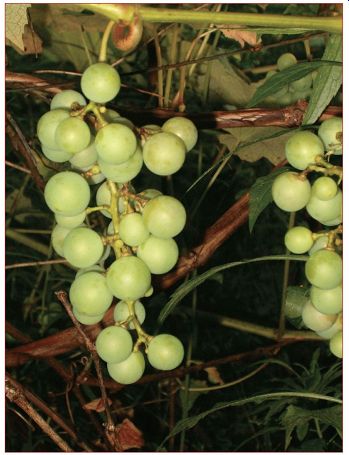
----------- Properly pruned grape vines yield good crops.
It is possible to start a grape vine in the fall, but odds of success are far greater if it is started in the spring because that gives the transplant more time to get established and store energy in its root system for overwintering.
When you first bring home a grape vine, it will likely have numerous shoots coming out of the root system. Cut off all of the shoots but the strongest one, then cut that one back to only three or four buds. Plant the vine in well-drained soil in a locale with plenty of sun, and water thoroughly. Pretty soon new shoots will emerge at the buds, plus some more from the roots. Cut off the ones that emerge from the roots, and once the new shoots from the buds have grown to about 12 inches, select the best and strongest of these and cut off the others. The best shoot will be pretty much upright. Drive a strong stake into the ground close to the plant, and throughout the summer keep the shoot tied nice and straight to that stake.
Meanwhile, set up your training and trellising system. There are many types, but about the easiest is the Kniffin system using two horizontal galvanized steel wires at three feet and six feet from the ground tied to two strong posts secured in the ground.
The first spring a year after planting, take the chosen shoot (which should have grown to a length somewhat taller than the bottom wire), and select the two strongest lateral shoots and tie those to the bottom wire while continuing to tie the growing trunk vertically to the stake.
Later in the season, once the growing trunk has grown to slightly below or slightly above the top wire, cut it off there and select the two strongest lateral shoots to tie to the top horizontal wires.
Occasionally, the chosen shoot that will serve as the trunk won't put out lateral shoots the first year . If that occurs-it's no big deal.
Grape vines are vigorous and forgiving, so if a mistake is made in one year, it can always be corrected the next year . Just take the main shoot that serves as the trunk once it is slightly above the first wire, and tie it to one side of the wire and trim it back to three or four buds. These will form shoots. Select the two strongest of these--one of which will be run horizontally in the opposite direction on the wire, and the other of which will be run vertically up the stake and handled as detailed previously.
Ongoing pruning will be important to maintain fruit production because grapes produce on the shoots that come from one-year-old wood. So any shoots that arise from wood that is more than one year old won't bear fruit. That means that the horizontal shoots selected the first year should be removed for the second year and new shoots from the trunk trained along the wires.
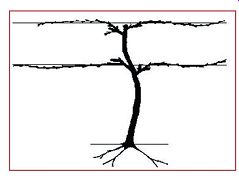
------------- The Kniffin system is one of the easiest for training grapes.
The foregoing is not the final word on grape pruning and training, as many other systems are available to those desiring more information--but this should be enough to get you started.
Grapes are prone to black rot and botrytis fungus, as well as birds and deer . Because of the rot and fungal problems, it is important to avoid sprinkler irrigation of grapes and practice good sanitation by consistently removing old fruit and leaves at the end of each season.
A copper-based fungicide applied at bloom time is most effective against rot and fungus.
On a small scale, birds and deer can be foiled with netting; on a larger scale, some creativity (such as noisemakers and fencing) will be required. I grow my grapes far away from everything else, and the birds and deer haven't found them so far!
Strawberries
Very few fruits are as prolific and easy to grow in limited space as strawberries. Moreover , because of their delicate nature, they are expensive to ship long distances, so they sell well in season if you decide to market them. Beds are easy to establish and require minimal maintenance on the scale of a mini-farm.
Strawberries come in three basic types: spring-bearing, ever bearing, and day-neutral. The spring-bearing variety produces a single crop; the ever-bearing variety produces crops in spring, summer , and fall; and the day-neutral strawberry produces fruit throughout the season. Spring-bearing varieties can be early season, middle season, or late season, meaning that through careful selection of more than one spring-bearing variety, it is possible to extend the length of harvest substantially. Consider the intended use of the strawberries-preservation or fresh eating-in selecting varieties for either a continuous small crop or one or more larger harvests.
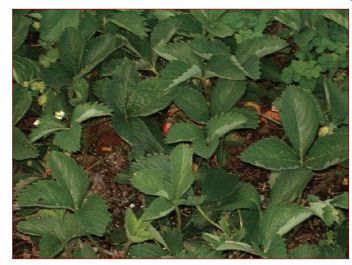
--------- Strawberries do extremely well in raised beds.
Strawberry plants can be spread either through seeds or through plants and runners. The best bet in most cases is to buy strawberry plants of known characteristics and then let them spread by runners.
Runners are a long stem that emerges from the crown of the strawberry plant and establishes a new crown and root system wherever it contacts suitable earth. Simply place the runners where they will fill in the gaps in your planting-no more than four strawberry plants per square foot.
Strawberries should be well fertilized with compost and any needed organic amendments and be mulched with straw or fallen leaves after the last frost. They occasionally fall prey to botyritis blight, a gray mold that can grow on the berries. To keep this controlled, keep the beds clear of debris, make sure strawberries are harvested when ripe or slightly underripe, and spray with an organic fixed-copper fungicide as needed.
Apples and Pears
Apples and pears are the quintessential home fruit trees and can be grown in almost any part of the United States. A wide selection of modern and heirloom varieties are available that are suitable for fresh eating, preservation, and pies.
Apples and pears offered in nurseries are usually produced by grafting the scion wood of the desired variety onto a more hardy compatible rootstock, such as that of flowering crab. The original rootstock can produce shoots below the graft (known as "suckers"), and these should be trimmed as soon as they are spotted.
Apples and pears should be pruned and trained when they are quite young or else they will become difficult to manage and produce inferior fruit. The objective of training the tree is to provide optimal air circulation and sunlight while keeping the fruit low enough to the ground so that it can be picked without a crane.
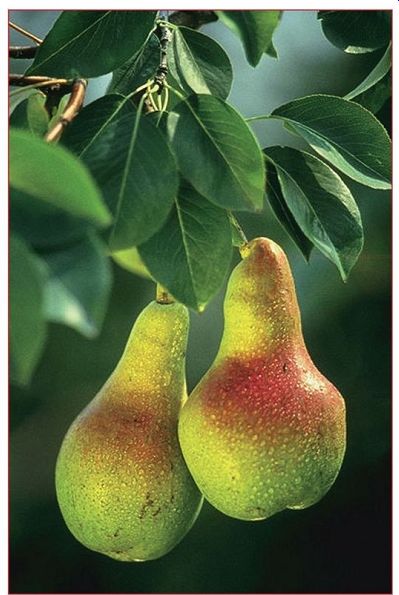
---------- Pears are a bit easier than apples to keep pest free.
It is easiest for a mini-farmer is to select dwarf or semidwarf trees from the beginning. This will reduce pruning requirements and make maintenance easier and safer . Ideally, the tree will be pruned so that the shape is similar to a Christmas tree, which will allow maximum penetration of sunlight and easiest spraying while keeping the greatest bulk of the fruit closest to the ground.
A large number of articles on the specifics of pruning and training pomme fruits are available, but it isn't hard to master if a few rules are followed. (Apples, pears, and quinces are collectively referred to as pomme fruits. The word pomme comes from the French word for apple.) When the young tree is first planted, tie it to a straight, eight-foot long stake driven at least three feet into the soil for strength, cut off any limbs that are larger than 50% of the diameter of the trunk, and trim the trunk back to a height of three feet. Branches are strongest when they leave the trunk at an angle between 60 and 75 degrees, so when the branches are young, it is easy to bring them back to that angle by tying them with string or inserting small pieces of wood between the branch and the trunk. The branches on trees will tend to grow toward the sun, so that tendency will have to be countered the same way because you want the tree to grow straight and well balanced.
Subsequent pruning is best done in late winter or very early spring. The first spring after planting, remove any limbs closer to the ground than two feet and any limbs that are larger than 50% of the diameter of the trunk. If the tree has developed more than seven limbs, select the seven best distributed around the tree to be saved, and prune the rest. It is important when a limb is pruned that it be pruned back all the way to the trunk, otherwise it will sprout a bunch of vertically growing wood and create troubles. Once the pruning is done, limbs that need it should be tied or fitted with spacers to get the right angle to the trunk.
Beware of cutting off just the tips of the remaining limbs, because this can delay fruiting. Once the tree has been fruiting for a couple of years, such cuts can be used sparingly for shaping, but it is better to solve shading problems by removing entire limbs.
For all following years use the same rules by aiming for a well balanced upright tree without excessive shading.
Stone Fruits
Stone fruits include cherries, apricots, peaches, plums, and nectarines. Because most stone fruits are native to warm climates and are thus susceptible to problems from winter injury or frost killing the flowers in the spring, it is important to carefully select varieties suitable for your area by consulting with a knowledgeable seller with a good reputation. No matter what cultivar is selected, it should be planted in an area protected from wind and with good sunshine and drainage. It is best to select a one-year-old tree five or six feet tall with good root growth.
Like apples and pears, stone fruits can be grafted onto dwarfing rootstocks. Unfortunately, none of the dwarf varieties grow well north of Pennsylvania.
The good news is that a number of hardy stone fruit varieties native to North America are available.
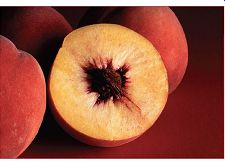
---------- Nectarines are easy to grow and easy to can or freeze.
The bush cherry (Prunus besseyi), American wild plum (Prunus americana), and American beach plum (Prunus maritima ) can be grown throughout the continental United States, and Indian blood peach (Prunus persica) can be grown south of Massachusetts. All of these are available in seed form from Bountiful Gardens (www.bountifulgardens.org) and are also available from a number of nurseries.
Almost all nursery stock is grafted rather than grown from seed for a number of reasons, but the effect of this is that if two trees of the same type and variety are selected, they may be genetically the same exact plant and thus incapable of pollinating each other , causing low fruit yields. More than one of any stone fruit should be selected to aid in pollination, and it is important to consult with knowledgeable nursery personnel about exactly what varieties need to be grown to ensure proper pollination. Space nectarines, peaches, plums, and apricots anywhere from 15 to 20 feet apart, and space cherries anywhere from 20 to 30 feet apart for best pollination and fruit yields.
Stone fruits should be planted in early spring by digging a hole big enough to accommodate the entire root system without bunching it up or looping it around and deep enough that the graft union is about two inches above the ground. Once the soil is filled back into the hole, the area should be watered thoroughly to help the soil settle around the roots. Stone fruits should be fertilized in early spring only (using a balanced organic fertilizer) and never later in the summer . Fertilizing in late summer will cause vigorous growth that the root system hasn't grown enough to support so the tree could be harmed and have difficulty overwintering. By fertilizing in the early spring, the tree has a chance to grow in a balanced way across the entire growing season so it will overwinter properly.
A good fertilizer can be made by mixing together 1 pound of bone meal, 1/2 pound of dried blood, and 3 pounds of dried kelp or greensand. Apply 1/2 pound to the soil surface around the drip line of the tree (the "drip line" is the area on the ground just under the widest branches) by using a crowbar to make four to eight holes six inches deep in a circle around the plant and sprinkling some of the fertilizer in each hole. Use 1/2 pound the first year , then an additional half pound every year thereafter until, in the ninth and subsequent years, 5 pounds are being used each spring. Stone fruits prefer a pH of 6.0 to 6.5, and if a soil test shows amendment to be needed, that can be done in the spring as well. Keep in mind, however , that lime can take several months to work, so don't over-lime and raise the pH above 6.5.
The following pruning directions are equally applicable to both dwarf and full-size trees. Because all stone fruits are susceptible to brown rot, they should be trained to an open center rather than a central leader (a single main trunk that reaches all the way to the top of the tree) like an apple tree. This will allow maximum light and air penetration to keep brown rot problems under control.
When the tree is first planted, cut off any branches closer than 18 inches to the ground, and cut the central leader at 30 inches above the ground. This will force branches to grow out at 18 to 30 inches above the ground, which will yield branches at the right height when the tree is mature. Select three or four good branches that are growing evenly spaced around the trunk, and prune back the others all the way to the trunk, then prune back the central leader to just above the topmost selected branch. These selected branches will be the main scaffolds of the tree, referring to their structural importance. Stone fruit branches are strongest when they leave the trunk at an angle between 60 and 90 degrees, so now is the time to establish those angles and the direction of growth using a combination of ropes and wooden spacers inserted between the branch and the trunk.
Stone fruits should not be pruned in winter because of susceptibility to winter injury and because of a disease called cytospora canker . Rather , they should be pruned between the time they bloom and the first week after the flower petals have fallen.
The first pruning after planting should occur just after blooming in the early spring of the next year . At that time, any branches that are broken and diseased should be removed, and the main scaffolds should be cut back half their length to an outward facing bud. Any vertically growing shoots should likewise be removed, and spacers or ties for maintaining branch angles should be checked and adjusted as necessary.
The second pruning after planting will occur at the same time the next year . By this time, the main scaffold branches will be developing new branches on them. Select three or four sublimbs on each main scaffold to be preserved. These should be on opposite sides of the scaffolds, not growing straight up or bending down, and be at least 18 inches away from the main trunk. The main scaffold branches should then be cut back by 1/3 to an outward facing bud, and all limbs but the selected sublimbs should be cut back to the branch or to the trunk as appropriate.
Subsequent pruning simply needs to maintain the open center by removing vertical limbs and limbs that grow inward toward the center . Limbs and sublimbs should be headed back to an outward facing bud each year to make sure new fruiting wood is growing each year , and limbs should be pruned as needed to maintain the desired shape and size of tree and to avoid broken limbs.
Nut Trees
Compared to fruit trees, nut trees are easier to prune and care for . The only downside is that, except for filberts, they grow to be quite large and thus require as much as 50 feet between trees.
Walnuts and, to a lesser extent, pecans and hickories produce a chemical called juglone in their root systems that inhibits the germination of other plants, so they shouldn't be planted close to a garden. A number of trees are unaffected by juglone, including cherries, oaks, pears, and most cone-bearing trees, among others.
The only vegetables unaffected by juglone are onions, beans, carrots, corn, melons, and squash.
Most nut trees aren't self-fruitful and therefore must be planted in pairs. The same caveat applies to nuts as to fruits in that many nut trees are made by grafting and thus are genetic clones. For this reason, two different varieties of the same nut will need to be planted unless those trees were grown from seed, in which case two trees of the same variety will work fine.
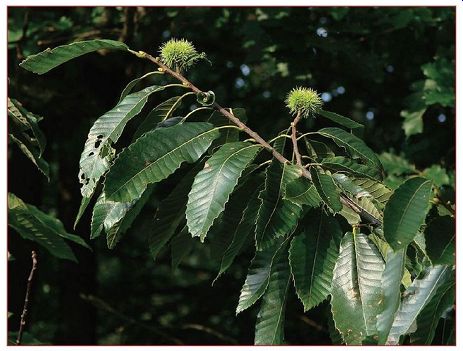
---------- Chestnuts, walnuts, and other nuts are highly nutritious.
Nut trees can be grown from seed as long as the requisite period of cold stratification is met to break dormancy. (Cold stratification means exposing the seed to a period of subfreezing temperature for a period of time. Many seeds for trees require this or they will never sprout.) If you plant the seed in the fall and protect it from rodents, it will sprout in the spring. Plant it about two feet deep and mulch with hay over the winter, then remove the mulch in early spring.
The tree should be transplanted into a hole big enough to handle the entire root system. About 2/3 of the soil should be carefully shoveled around the roots and then well watered and the remaining soil shoveled in and tamped down. The area around the tree should then be mulched to reduce competition with weeds and the trunk protected with a circular hardware cloth protector to keep deer and other critters from eating the bark. (Hardware cloth is available at any hardware store at minimal cost.) Because nut trees have a long taproot that grows slowly, they need to have about half of their top growth pruned back during transplanting, leaving several buds. This balances the upper and lower portion of the tree to enhance survivability. New vertical growing shoots should emerge from the buds left behind, and when they are 8 to 12 inches long, the most vigorous should be selected as the tree's new central leader , and the remainder cut off even with the trunk.
From that point forward, you are mainly aiming for a balanced
tree, so prune to keep the tree balanced. Conduct all pruning in late winter or very early spring, and remove all dead or damaged branches. At the same time, progressively shorten the lowest limbs a little each year until the tree is about 20 feet high, at which point all limbs lower than 6 feet should be removed flush with the trunk.
This preserves the food-making ability of the lower limbs until it is no longer needed.
Growing distance/productivity for such large trees can be troublesome on a small lot, but there are ways to get around the problem. Table 17 gives the ultimate distance that the trees should be from each other when fully grown.
------------- Table 17: Nut Tree Planting Distance
Type of Nut Tree
Distance between Trees
Black walnut, hickory, pecan, and hican
50 feet in all directions
English and Persian walnut 35 feet in all directions
Chestnut (Chinese, most American chestnuts succumbed to the chestnut blight)
40 feet in all directions
Filberts
15 feet in all directions
---------------
Keep in mind that nut trees produce nuts long before reaching full size and that nut wood is some of the most expensive, so selling it could net a nice bundle. If you wish to do so, plant the nut trees about 10 feet apart and then selectively harvest them for wood as their branches come close to touching. In the end, you have properly spaced highly productive nut trees and hopefully a wad of cash.
Diseases and Pests
There's no such thing as a free lunch-or even free fruit! Fruit and nut trees are prone to numerous pest and disease problems. Thus, they require a regular schedule of sanitation and spraying to keep them healthy and productive, and they can pose a challenge to mini farmers, particularly if they are committed to raising fruit without synthetic pesticides. This is more of a problem with fruits than with nuts, but it can be made manageable through advanced planning and a thorough understanding of the requirements. Pomme fruits such as apples and pears share common pests and diseases, as do stone fruits such as cherries, plums, and peaches. No matter what fruits you grow or what diseases are prevalent, meticulous cleanup of debris around the trees and vigilant pruning of diseased tissues will provide the proverbial "ounce of prevention." The difficulties of raising apples and pears explain the high concentrations of toxic contaminants in nonorganic varieties.
Therefore you should carefully consider if some other fruit might be more suitable given the amount of time you will need to spend if you wish to produce organic apples and pears. According to the Agricultural Sciences department at Pennsylvania State University, as many as 6 to 10 pesticide applications might be required yearly to produce reasonably appealing apples, though as few as 2 or 3 applications are feasible with scab-resistant varieties. Spraying is simplified, and pomme fruits are more practical if dwarf varieties are selected.
Scab is a fungal disease of apples and pears. The spores mature over a four- to six-week period of wet weather in the spring that corresponds with the wet weather required for the release of the spores. The spores take up residence on the leaves of the tree where they grow and produce more spores, starting a cycle of re-infection that infects the fruit as well, causing ugly, misshapen fruit. If all debris (apples/pears and leaves) is removed before the spores can be released, and a good antifungal agent (such as fixed copper or Bordeaux mix) is applied every 10 to 14 days starting in early spring and extending through early summer , scab infection can be controlled. A better solution, because antifungal agents can injure the tree, is to plant apple varieties that are naturally resistant to scab, such as Liberty. Carefully research the varieties you plan to grow.
There are a number of other apple or pear diseases, such as fire blight, that require comprehensive management programs to produce good fruit. Antibiotics are combined with pruning of diseased tissue for treatment of fire blight once it becomes established.
The most prevalent pest of pomme fruits is the apple maggot, a little white worm. Luckily, the apple maggot is one of the few insects that can discern--and are attracted to--the color red. They can be effectively controlled by hanging red-painted balls coated with a sticky coating (such as Tangletrap). The balls should be hung just after flowering and remain through harvest, being renewed periodically to keep them sticky. Several are required for each tree.
The codling moth is another serious pest. This nondescript gray and brown moth lays eggs on the fruit. The first eggs hatch when the fruit is slightly less than one inch in diameter , and the small worm burrows into the fruit where it eats until it reaches full size then burrows back out, becomes a moth, and starts the cycle again.
Codling moths are conventionally controlled by spraying carbaryl or permethrin at least once every 14 days following petal fall. These poisons can be avoided by aggressive organic measures including "trapping out" the male moths by using up to four pheromone traps per full-sized tree, encircling the tree trunks with flexible cardboard covered with a sticky coating to trap the larvae, and spraying frequently with the botanical insecticide ryania.
Stone fruits, like pomme fruits, require constant spraying to deal with a number of diseases and pests. Chief diseases include powdery mildew, leaf spot, peach leaf curl, crown gall, cytospora canker , black knot, and brown spot. Japanese beetles, fruit moths, aphids, borers, and spider mites round out the threats.
A regular spraying schedule is required for stone fruits. If raising the fruit organically, this includes fungicides such as Bordeaux mix, lime sulfur , and fixed copper and insect controls such as neem oil, horticultural oil, and organic insecticides used according to label directions. The spraying should start when buds swell in the spring and continue with the frequency specified on the product label until the fruit has been harvested. All dropped fruit and leaves should be raked up and removed from the area in the fall.
Black knot of the plum can't be controlled this way and instead requires that any sections of wood evidencing this distinctive infection be completely removed from the tree and destroyed by incineration.
Most nut trees never show signs of disease, and the regular spraying required for fruit trees is not needed in most cases. Major nut tree diseases include chestnut blight, pecan scab, walnut anthracnose, and walnut blight.
Chestnut blight was introduced into the United States before 1900 through the importation of various Asian chestnut species that carry the causative fungus but are resistant to it themselves. The American chestnut, native to Eastern North America, has no resistance to this fungus; within a generation this majestic tree, soaring up to 100 feet and measuring up to 10 feet across, was reduced to little more than a shrub that struggles a few years before succumbing to the threat. To put the impact of chestnut blight into perspective, it is estimated that in 1900, 25% of all the trees in the Appalachians were American chestnuts.
There are four ways of dealing with chestnut blight: prompt removal of infected branches, treatment of cankers in existing trees for five years with injections of a hypovirulent strain of the fungus, planting resistant Asian chestnut varieties, and planting American varieties that have incorporated disease-resistant genes through repetitive backcrossing and selection to maximize native DNA content while retaining resistance genes.
Mini-farmers interested in growing and preserving American chestnuts should seek guidance (and seeds!) from the American Chestnut Cooperators' Foundation (accf-online.org). Farmers interested in resistant Asian stocks can find suitable varieties at local nurseries.
Pecan scab, evidenced by sunken black spots on leaves, twigs, and nuts, is more of a problem in the southern than northern states.
At the scale of a mini-farm, it is most easily controlled through meticulous sanitation--the raking and disposal of leaves and detritus through burning. Severe infestations require multiple fungicide sprays yearly.
Walnut anthracnose, a disease characterized by small dark spots on the leaves that can grow to merge together and defoliate entire trees in severe cases, affects black walnuts but not Persian varieties.
Meticulous sanitation is normally all that is required on the scale of a mini-farm, but springtime fungicide spraying may be needed in severe cases.
Walnut blight is just the opposite in that it affects the Persian walnut varieties but not American black walnuts. Walnut blight looks like small, water-filled sunken spots on leaves, shoots, and/or nuts.
The disease doesn't travel back into old wood, so the tree and crop can be saved by spraying fixed copper during flowering and fruit set.
Pest insects in nut trees can be controlled through keeping the area mowed and free of tall grasses that would harbor stinkbugs, meticulous sanitation to control shuckworms, and regular insecticide spraying to control hunkflies, weevils, and casebearers. For a handful of nut trees (unless the mini-farm is in close proximity to a large number of similar nut species), pests are unlikely to become a major problem, and it is likely that spraying will never be necessary.
----